Trips on a Train
From childhood I have been fascinated by trains. Perhaps it is the gigantic mass of moving machinery, or the quasi-romance associated with railroads that attracted me, but whatever it is, it's still alive within me. I would have loved to have enjoyed a career with a railroad company, but I had the misfortune to be completing college at a time when railroads were in a precipitious decline and masses of employees were being shown the exit door. Spilt milk at this point.
While doing some online research I found two excursion trains located relatively close to each other and not that far from my den of iniquity; one in Elkins WV and a second at Cass, WV. Both are the salvaged remnants of once-booming businesses that served both the logging and coal mining industries from the 1880's until the 1960's. As the lights began to go out for these railroads, a few visionaries and other dreamers jumped in ahead of the scrappers and the land merchants to snag the rusting and neglected remains of crashing railroad companies. In one case the State of West Virginia, in an uncommon burst of bureaucratic wisdom, grabbed land, buildings, & equipment, to create a state park before devastation and dispair could take over. In combination with the unbridled passion of a handful of volunteers, 'excursion' railroads were born from the ashes of economic failure to the delight of families and geezers of various ages.
DAY ONE:
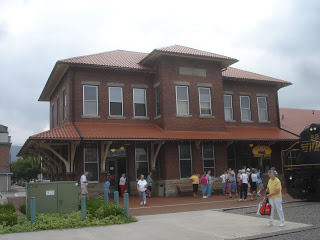 There is an excitement that accompanies walking toward a restored and immaculately maintained railroad station with "1908" emblazoned on a stone tablet set high below a roof overhang. It's a chance to escape the disposability of today for a brief return to the strength, elegance, and permanence of long ago. The thrill fades a bit when faced with the 'gift shop frenzy' of children and adults pawing through pink engineer hats, multi-colored tee shirts, plastic trains, and wooden train whistles made in China. If you make an honest effort to stick with admiring the architecture, the buzz stays a bit longer. Then the building begins to shake and an ever-louder roar signals the approach of a 1500 horsepower shark-nose diesel-electric locomotive built in 1947. The blast of the horn is deafening and sends whiney children screaming back to their mothers, but sends a welcomed chill down my spine.
There is an excitement that accompanies walking toward a restored and immaculately maintained railroad station with "1908" emblazoned on a stone tablet set high below a roof overhang. It's a chance to escape the disposability of today for a brief return to the strength, elegance, and permanence of long ago. The thrill fades a bit when faced with the 'gift shop frenzy' of children and adults pawing through pink engineer hats, multi-colored tee shirts, plastic trains, and wooden train whistles made in China. If you make an honest effort to stick with admiring the architecture, the buzz stays a bit longer. Then the building begins to shake and an ever-louder roar signals the approach of a 1500 horsepower shark-nose diesel-electric locomotive built in 1947. The blast of the horn is deafening and sends whiney children screaming back to their mothers, but sends a welcomed chill down my spine. Stepping outside I am confronted by a huge beast that sits at thunderous idle, diesel fumes spewing from its exhaust stack. Power throbs from within it, vibrating anything nearby. It is sleek and beautifully curved, painted shiny black and emblazoned with "WESTERN MARYLAND" in bold yellow letters that seem to extend to the horizon. Like the impulse to touch a wild animal, I am filled with the desire run my hands over the smooth, curving surfaces. High above me the large glowing headlight shines like a single eye. All about the machine are wires, pipes, and conduits. A pipe railing guards workers who must stand at the front as well as inconsiderate and disrespectful tourists. High above sits the engineer in his windowed chamber, master of all that will happen on this day. There is a feeling of awe that mere men could build such a grand and powerful creature as this.
Stepping outside I am confronted by a huge beast that sits at thunderous idle, diesel fumes spewing from its exhaust stack. Power throbs from within it, vibrating anything nearby. It is sleek and beautifully curved, painted shiny black and emblazoned with "WESTERN MARYLAND" in bold yellow letters that seem to extend to the horizon. Like the impulse to touch a wild animal, I am filled with the desire run my hands over the smooth, curving surfaces. High above me the large glowing headlight shines like a single eye. All about the machine are wires, pipes, and conduits. A pipe railing guards workers who must stand at the front as well as inconsiderate and disrespectful tourists. High above sits the engineer in his windowed chamber, master of all that will happen on this day. There is a feeling of awe that mere men could build such a grand and powerful creature as this.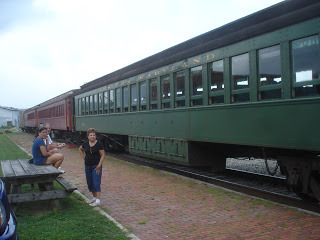
At the appointed time the mass of passengers is invited to board creating an odd exodus of humanity from the platform into the 1920's vintage railcars. The older and wiser grab the thickly padded seats in the luxury coach while the stragglers and distracted are left to the hard wooden seats of the other two coaches. After several ear-shattering blasts of the horn and a jolt, the train begins to move, leaving the station in Elkins behind.
The next three hours are a journey into history. Atop rails seeing their second century the train cruises along the almost overgrown railway. Tree limbs that defy the best trimming efforts of the volunteers reach out and occasionally brush the cars. Black powder blasted rock walls threaten to crumble onto the roadbed. A long, dark tunnel adds a degree of mystery to the trip. The cars rock steadily as the train continues on its way. The aged conductor provides an enthusiastic narration of the facts and history of the railroad. Mercifully, at the end of the line, two busloads of bored children, exhausted parents, and semi-aware seniors leave the train and return to their charter buses for a trip to yet another excursion railway, leaving only a handful of hearty souls to gather around the conductor while he spins yarns and tells the stories that would have been wasted on the busloads. Now the trip begins to have meaning, creating memories worth remembering during the three hours back to the station.
One of the things I learned was that a six hour trip is long whether by train, airplane, or bus. I was grateful to finally be on firm ground again, but I could not resist one last admiring study of the grand old engine that had served us so well. I feel a kind of kinship for anything that has spent 63 years working hard and will be back again tomorrow to do it all again. Better it than me.
DAY TWO:
Where IS this place? The four-lane became a two-lane. The two-lane became a twisting, winding, narrow monster that climbed and crashed like a roller coaster. Mapquest had been accurate in its 1-1/2 hour time estimate of the trip from Elkins to Cass, but what it didn't tell me was how much really hard driving I would encounter. Finally a valley opened up at the end of a small village of white-painted houses and other buildings to reveal a train station and a cluster of white-painted industrial buildings. The paved parking lot was wide and not crowded at all, affording me convenient parking. Welcome to Cass Scenic Railroad State Park. Fortunately the 'will call' line for pre-paid tickets was much shorter that the 'Buy Tickets Here' line where adults couldn't seem to understand phrases like, "We cannot accept personal checks" and, "Children over 12 pay adult fares". We pitied the poor ticket clerk who had to answer a stupid question with, "We cannot tell you where to put your dog, but it cannot go on the train." I got the impression that for some people, the train to common sense stopped long before it reached their station.
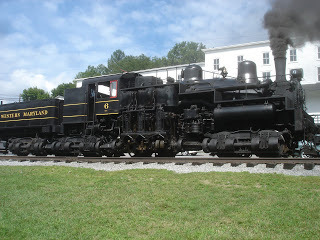 Ticket in hand, I carefully avoided the gift shop in favor of an old corrugated metal building labelled "Cass Showcase". Once inside I was treated to a scale model of the town as it existed in 1908, a narrated history provided by a knowledgeable gentleman, and a wonderful 10-15 minute movie. All were quite interesting, and the end of the movie was punctuated by the melodic scream of a steam whistle. When I exited the building, a huge black steam locomotive with four passenger cars sat at the depot. I would learn later that the engine before me was a 160 ton Shay steam locomotive, the second largest ever built, constructed in 1945 in Lima, Ohio. It was a magnificent creature, vastly different from the shapely diesel of Elkins and unlike anything I had ever seen.
Ticket in hand, I carefully avoided the gift shop in favor of an old corrugated metal building labelled "Cass Showcase". Once inside I was treated to a scale model of the town as it existed in 1908, a narrated history provided by a knowledgeable gentleman, and a wonderful 10-15 minute movie. All were quite interesting, and the end of the movie was punctuated by the melodic scream of a steam whistle. When I exited the building, a huge black steam locomotive with four passenger cars sat at the depot. I would learn later that the engine before me was a 160 ton Shay steam locomotive, the second largest ever built, constructed in 1945 in Lima, Ohio. It was a magnificent creature, vastly different from the shapely diesel of Elkins and unlike anything I had ever seen.
An incredibly complicated machine, it had a boiler and a cab, but other than that it bore no resemblance to the usual steam locomotives. There are three exposed steam cylinders on each side and the cylinders drive a long crankshaft along the lower right side of the unit. This crankshaft drives gears at each of the six wheels, including two beneath the tender. Since the six wheels are rigidly connected to axles and the wheels on the other side, technically it is a 'twelve wheel drive' machine. It is the locomotive equivalent of 'all wheel drive', which was necessary to negotiate the steep grades encountered while climbing the mountains where logging operations were being conducted. As I studied it, I began to realize what an absolute marvel it is that something like this could still be in regular service after all those years. Unlike the relatively smoke-free diesel, a steady cloud of black coal smoke chugged from the stack while water leaked from the botton and steam hissed from relief valves. It was both frightening and strangly magnetic at the same time. It was like staring at a bomb with the strange compulsion to see what that large red button does.
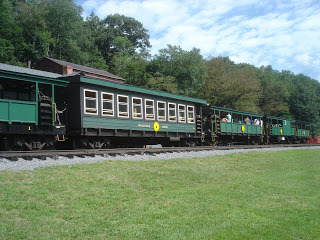 Three of the passenger cars were open-air with a roof and continuous bench seats that faced outward, while the other was enclosed. Rather than fight for a place in the 'cheap seats', I had reserved a seat in the 'first class' enclosed car that left me in the company of about a dozen other hearty souls. It didn't take long for most of us to abandon the seats in favor of standing at a window. With the cars loaded, the steam whistle screamed again and we were on our way.
Three of the passenger cars were open-air with a roof and continuous bench seats that faced outward, while the other was enclosed. Rather than fight for a place in the 'cheap seats', I had reserved a seat in the 'first class' enclosed car that left me in the company of about a dozen other hearty souls. It didn't take long for most of us to abandon the seats in favor of standing at a window. With the cars loaded, the steam whistle screamed again and we were on our way.It is right that different locomotives have different styles of horns. The diesel at Elkins had a deep, badass horn that could peel the paint off of a building, but it would have been entirely wrong for a steam train. The steam locomotive had one B-I-G steam whistle, the kind that companies used to have to tell employees when the shift had started or ended. Any of you who remember company towns will also remember the big steam whistle that was the focal point of the day. It would echo through the valley and carry for miles. Like the last school bell, everyone eagerly awaited the afternoon whistle marking the end of the shift. And occasionally, an untimely whistle meant that someone's Father wasn't coming home.
The engineer on this steam train was a maestro in his own right. Rather than just the required blasts, he created staccato rhythms and sliding melodic tones as a signature in which, I'm certain, he took great pride. With whistle blowing, we started down the tracks from Cass past a line of other locomotives in various stages of restoration or dismantling. We passed various storage cars and the large shop where the old is made new again, or at least patched up for a few more days. Then we started up the mountain.
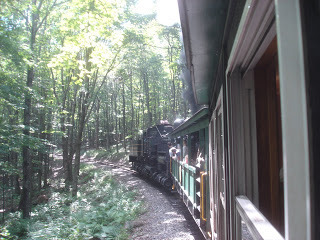
Most trains operate at a maximum grade of about 2% or two feet vertically in one hundred feet. Beyond that, their drive wheels begin to slip on the steel rails. Applying sand to the rails may help gain an extra percent or two, but that is about the limit. Almost immediately we were at 9%, a gradient that sent most people to their seats and kept them there. The ancient engine worked its mechanical heart out with clouds of bellowing smoke and flying pistons spinning the driveshaft. But up we went.
A switchback is like a landing on a long flight of stairs. You travel as far as you can in one direction, then pull into a level area, throw a rail switch, and start up again in the opposite direction to the next switchback. This continues as many times as necessary to get the huge load up the steep part of the mountain to an area where the grade flattens out. Pretty amazing stuff for 1908 and equally amazing that it is still in operation 100 years later.
Whitaker Station was a staging area where the loggers set up what they still call a 'yarder' that drags the felled logs on a cable to a central point for transport down the mountain. The cables could stretch for miles and tens of thousands of logs were removed this way. What I found interesting was the gigantic scope of the operation. This wasn't Joe Bob and Billy with a saw and a team of mules, this was dozens of teams of men who cut and moved trees 11 hours a day, 6 days a week for years. History says that the mountain was clear cut in the 1900's, then again in the 1930's, but you would never know it today. The mountain is so thickly wooded that the tree canopy is continuous as far as the eye can see. Even from the top of the mountain there are no open areas save for a handful of farms on the few flatter areas. I remember those sad old pictures from the 1900's that showed land cleared for miles around with acres of stumps and unprotected soil. They were usually accompanied by pictures of mustashioed men in front of a large train or in front of a pile of logs and shown as part of a PBS special on soil erosion. The earth is a very resilient critter.
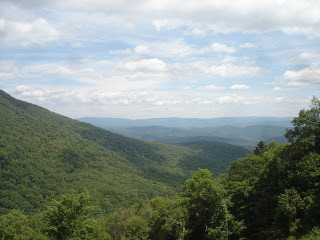
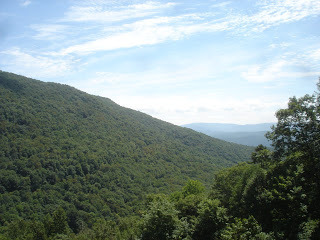
After visiting the sites of two abandoned logging towns and a couple of engineering feats, we began our descent back down the mountain. It is disconcerting to start down an 11% grade in front of 160 tons of steel and steam on wheels. Looking through the open cars at that huge boiler, I couldn't help but hope that those 65 year old brakes would hold until we reached level ground. Despite trust in competent people, there seems to be a point where those 'Stephen King' thoughts start to pop up. But in the end, thoughts were needless as we slowly and steadily returned to the Village of Cass.
All told it was a very nice couple of days. I have grown to appreciate history and the people who comprised it. It is equally satisfying to experience the efforts of those who put their passions into action so that others may experience a bit of the times long behind us.



